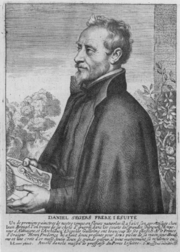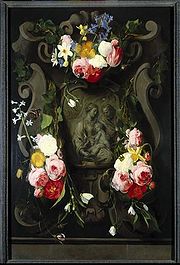
Daniel Seghers
Encyclopedia

Still life
A still life is a work of art depicting mostly inanimate subject matter, typically commonplace objects which may be either natural or man-made...
s, and is particularly well-known for his contributions to the genre of "flower garland" painting. His paintings were collected enthusiastically by courtly patrons and he had numerous imitators. He was the elder brother of the painter Gerard Seghers
Gerard Seghers
Gerard Seghers , also Zegers, was a Flemish Baroque painter and one of the leading Caravaggisti in the Southern Netherlands.-Biography:...
.
Biography
Born in Antwerp, Seghers moved to the Dutch RepublicDutch Republic
The Dutch Republic — officially known as the Republic of the Seven United Netherlands , the Republic of the United Netherlands, or the Republic of the Seven United Provinces — was a republic in Europe existing from 1581 to 1795, preceding the Batavian Republic and ultimately...
around 1601, following the death of his father Pierre and the conversion of his mother to Calvinism
Calvinism
Calvinism is a Protestant theological system and an approach to the Christian life...
. The young artist returned to Antwerp by 1611, where he was enrolled in the guild of St. Luke as a student of Jan Brueghel the Elder
Jan Brueghel the Elder
Jan Brueghel the Elder was a Flemish painter, son of Pieter Bruegel the Elder and father of Jan Brueghel the Younger. Nicknamed "Velvet" Brueghel, "Flower" Brueghel, and "Paradise" Brueghel, of which the latter two were derived from his floral still lifes which were his favored subjects, while the...
. After re-converting back to Catholicism
Catholicism
Catholicism is a broad term for the body of the Catholic faith, its theologies and doctrines, its liturgical, ethical, spiritual, and behavioral characteristics, as well as a religious people as a whole....
, in 1614 he became a noviciate in the Jesuit order in Mechelen
Mechelen
Mechelen Footnote: Mechelen became known in English as 'Mechlin' from which the adjective 'Mechlinian' is derived...
. Until 1625 Seghers continued to work as a painter in Antwerp, as well as a stay in Brussels
Brussels
Brussels , officially the Brussels Region or Brussels-Capital Region , is the capital of Belgium and the de facto capital of the European Union...
in 1621. Sources differ regarding his status in the Jesuit order: some claim that he was ordained a priest in 1625, while other argue that he remained a lay brother
Lay brother
In the most common usage, lay brothers are those members of Catholic religious orders, particularly of monastic orders, occupied primarily with manual labour and with the secular affairs of a monastery or friary, in contrast to the choir monks of the same monastery who are devoted mainly to the...
. Between 1625 to 1627, the artist was in Italy
Italy
Italy , officially the Italian Republic languages]] under the European Charter for Regional or Minority Languages. In each of these, Italy's official name is as follows:;;;;;;;;), is a unitary parliamentary republic in South-Central Europe. To the north it borders France, Switzerland, Austria and...
, and from 1627 until his death in 1661, Seghers remained mostly in Antwerp.
Work

Flower garland paintings
Seghers's work reflects a distinctively Flemish genre in which a garland of flowers surrounds an image of the madonnaMadonna (art)
Images of the Madonna and the Madonna and Child or Virgin and Child are pictorial or sculptured representations of Mary, Mother of Jesus, either alone, or more frequently, with the infant Jesus. These images are central icons of Roman Catholicism and Eastern Orthodox Christianity where Mary remains...
, a saint and other religious symbols. This type of picture had been invented by Seghers's teacher Jan Brueghel and Federico Borromeo
Federico Borromeo
Federico Borromeo was an Italian ecclesiastic, cardinal and archbishop of Milan.-Biography:Federico Borromeo was born in Milan as the second son of Giulio Cesare Borromeo, Count of Arona, and Margherita Trivulzio...
at the beginning of the seventeenth century, and was initially connected to the visual imagery of the Counter-Reformation movement. Seghers distinguished himself from his teacher by including cartouche
Cartouche
In Egyptian hieroglyphs, a cartouche is an ellipse with a horizontal line at one end, indicating that the text enclosed is a royal name, coming into use during the beginning of the Fourth Dynasty under Pharaoh Sneferu, replacing the earlier serekh...
s as framing elements. By the second half of the century, however, secular themes such as portraits and mythological subjects also decorated the central part of the many paintings made in this fashion..
Collaboration
Seghers himself generally only painted the flowers—frequently locally-grown roses and tulips that are just about to bloom—and the central subject was filled in later by another artist. This spirit of artistic collaboration, which was seen in the earliest flower garland paintings by Brughel and Peter Paul Rubens, is, in fact, a notable quality of Flemish painting in seventeenth-century Antwerp. Although many of Seghers collaborators were anonymous local artists, he often worked with Cornelis SchutCornelis Schut
Cornelis Schut was a Flemish Baroque painter, draughtsman and engraver active in Italy and Antwerp.-Biography:...
(44x), Erasmus Quellinus II
Erasmus Quellinus II
Erasmus Quellinus II was a Flemish Baroque painter specializing in architectural perspective studies. He worked in the studio of Peter Paul Rubens.-Biography:He was born in Antwerp as the son of Erasmus Quellinus I and Elisabeth van Uden...
(28x), Abraham van Diepenbeek (6x), Simon de Vos
Simon de Vos
Simon de Vos was a Flemish Baroque painter of genre and cabinet pictures.-Biography:De Vos studied with Cornelis de Vos , to whom he is not related, from 1615 until 1620. In 1620 he joined Antwerp's guild of St...
(6x), Jan van den Hoecke
Jan van den Hoecke
Jan van den Hoecke , also known as Johannes or Giovanni and van Hoek, van Hoeck, or Vanhoek, was a Flemish Baroque painter and draughtsman. He was born and died in Antwerp.-Biography:...
(2x), Gonzales Coques (2x) and Rubens
Rubens
Rubens is often used to refer to Peter Paul Rubens , the Flemish artist.Rubens may also refer to:- People :Family name* Paul Rubens Rubens is often used to refer to Peter Paul Rubens (1577-1640), the Flemish artist.Rubens may also refer to:- People :Family name* Paul Rubens (composer) Rubens is...
(2x). Thomas Willeboirts Bosschaert is mentioned as his assistant. In a process counter to his later works, Seghers appears to have added flower garlands to existing paintings by Domenichino during his time in Rome.
Reception
Daniel Seghers's art was widely admired during his lifetime, generating great interest from collectors and spawning imitators such as Jan Philips van ThielenJan Philips van Thielen
Jan Philips van Thielen was a Flemish Baroque painter who specialized in flowers.-Early life:Van Thielen was the son of a minor nobleman and eventually assumed the title of Lord of Couwenberch...
. His paintings were highly prized and collected at the court of Frederik Hendrik
Frederick Henry, Prince of Orange
Frederick Henry, or Frederik Hendrik in Dutch , was the sovereign Prince of Orange and stadtholder of Holland, Zeeland, Utrecht, Guelders, and Overijssel from 1625 to 1647.-Early life:...
in the Hague. There, the art collector and secretary to the prince Constantijn Huygens
Constantijn Huygens
Constantijn Huygens , was a Dutch Golden Age poet and composer. He was secretary to two Princes of Orange: Frederick Henry and William II, and the father of the scientist Christiaan Huygens.-Biography:...
praised the paintings in poetry and corresponded numerous times with the artist, writing that one could almost smell the flowers. The Dutch poet Joost van den Vondel
Joost van den Vondel
Joost van den Vondel was a Dutch writer and playwright. He is considered the most prominent Dutch poet and playwright of the 17th century. His plays are the ones from that period that are still most frequently performed, and his epic Joannes de Boetgezant , on the life of John the Baptist, has...
also wrote highly of Seghers's paintings. Other collectors include Christina of Sweden
Christina of Sweden
Christina , later adopted the name Christina Alexandra, was Queen regnant of Swedes, Goths and Vandals, Grand Princess of Finland, and Duchess of Ingria, Estonia, Livonia and Karelia, from 1633 to 1654. She was the only surviving legitimate child of King Gustav II Adolph and his wife Maria Eleonora...
, Charles I
Charles I of England
Charles I was King of England, King of Scotland, and King of Ireland from 27 March 1625 until his execution in 1649. Charles engaged in a struggle for power with the Parliament of England, attempting to obtain royal revenue whilst Parliament sought to curb his Royal prerogative which Charles...
, Philip IV of Spain
Philip IV of Spain
Philip IV was King of Spain between 1621 and 1665, sovereign of the Spanish Netherlands, and King of Portugal until 1640...
, Maria de' Medici and Charles II
Charles II of England
Charles II was monarch of the three kingdoms of England, Scotland, and Ireland.Charles II's father, King Charles I, was executed at Whitehall on 30 January 1649, at the climax of the English Civil War...
, who visited the artist in 1649, and Archduke Leopold Wilhelm of Austria
Archduke Leopold Wilhelm of Austria
Archduke Leopold Wilhelm of Austria was an Austrian military commander, Governor of the Spanish Netherlands from 1647 to 1656, and a patron of the arts.-Biography:...
.
Many of Seghers's paintings are oil
Oil paint
Oil paint is a type of slow-drying paint that consists of particles of pigment suspended in a drying oil, commonly linseed oil. The viscosity of the paint may be modified by the addition of a solvent such as turpentine or white spirit, and varnish may be added to increase the glossiness of the...
on copper
Copper
Copper is a chemical element with the symbol Cu and atomic number 29. It is a ductile metal with very high thermal and electrical conductivity. Pure copper is soft and malleable; an exposed surface has a reddish-orange tarnish...
, a support often used for cabinet painting
Cabinet painting
A cabinet painting is a small painting, typically no larger than about two feet in either dimension, but often much smaller. The term is especially used of paintings that show full-length figures at a small scale, as opposed to say a head painted nearly life-size, and that are painted very...
s. In fact, his paintings were not sold through traditional contacts such as art dealers, but were instead presented as gifts by the Jesuit order to those, including members of the nobility, who were providing funds for the running of their schools.

